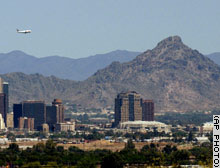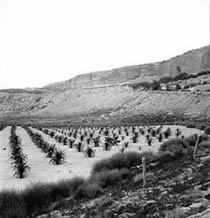| (insert your NIE or newspaper logo here) |
Weekly Online LessonOnline Lesson ArchiveGrade Level: 5-12
|
Honoring the Hopi
 As the American military turns its focus to restoring order and rebuilding Iraqi communities, some soldiers are returning from the region. Several military units have recently received orders to come home, while seven former prisoners of war were welcomed by a cheering crowd in Texas last Saturday.
As the American military turns its focus to restoring order and rebuilding Iraqi communities, some soldiers are returning from the region. Several military units have recently received orders to come home, while seven former prisoners of war were welcomed by a cheering crowd in Texas last Saturday.
But as these soldiers return to their families and friends, others may never return from the war. The current count estimates that more than 100 Americans have been killed or remain missing.
One such soldier is Army Pfc. Lori Piestewa, a Hopi from northeastern Arizona who was the first military servicewoman to die in the war. Piestewa (pronounced py-ESS-tuh-wah) was among nine members of the Army's 507th Maintenance Company killed in an ambush near Nasiriyah last month.
 Piestewa, of Tuba City, Ariz., was also one of the few American Indians serving in the armed forces. To honor her memory, Gov. Janet Napolitano proposed renaming a mountain near Phoenix, changing it from Squaw Peak to Piestewa Peak.
Piestewa, of Tuba City, Ariz., was also one of the few American Indians serving in the armed forces. To honor her memory, Gov. Janet Napolitano proposed renaming a mountain near Phoenix, changing it from Squaw Peak to Piestewa Peak.
Since American Indians often feel the term "squaw" is offensive to their heritage and culture, the renaming not only honors Piestewa but also wipes this derogatory reference off the map. The change was approved by the Arizona Geographic and Historic Names Board on April 18, 2003, and the governor hopes to soon rename the city's Squaw Peak Freeway as Piestewa Freeway.
In this week's lesson, to further honor Pfc. Lori Piestewa, you'll explore the rich culture and history of her people, the Hopi.
Hopi Roots
 Generally, the place where people live influences how their society and culture evolve over time. And there's no place better to start learning about this ancient culture of the Southwest's Four Corners region than at the Hopi Tribe's official website.
Generally, the place where people live influences how their society and culture evolve over time. And there's no place better to start learning about this ancient culture of the Southwest's Four Corners region than at the Hopi Tribe's official website.
Begin by reading the History overview. About how long have Hopi occupied this region? What does the name "Hisatsinom" mean? What types of crops did they farm? How did Hopi lifestyle change as environmental and social conditions changed?
Next explore the Culture section, starting with The Hopi Emergence - the people's creation story. How did the creatures change when they entered each of the Four Worlds? How does the story provide a type of cultural memory for how the Hopi arrived and survived in this desert region?
 Again from the Culture index, browse through the different topics, visiting one or more sections within each topic:
Again from the Culture index, browse through the different topics, visiting one or more sections within each topic:
- Arts and Crafts
- Ceremonies
- Clans
- Language
- Farming
- Housing
- Traditional Clothing
- Traditional Hopi Games
How does each of the different social, religious, technological, agricultural and material developments relate to where the Hopi lived? For example, how was house construction dependent on the local climate and the types of building materials available? In what language does Hopi belong, and how did three different dialects develop?
How did their social guidelines influence how clan members treated each other, as well as relationships between clans? How are their traditional customs different from other American Indian tribes with which you're familiar?
The Hopi Today
 Although the Hopi people were once widespread across this region, years of pressure from Navaho tribes and the U.S. government has shrunk their territory to a 1.6 million-acre holding surrounded by the Navaho Reservation.
Although the Hopi people were once widespread across this region, years of pressure from Navaho tribes and the U.S. government has shrunk their territory to a 1.6 million-acre holding surrounded by the Navaho Reservation.
Check out how Hopi are living today beginning at the tribe's Statistical Abstract section. Locate The Hopi Reservation with Arizona, and browse the Demographics and Climate and Geography pages. What's the average annual income? What's the unemployment rate? What percentage of Hopi residents have graduated from high school?
From the Hopi Tribe website's home page, read more about the Villages, the Tribal Government, the Hopi Tutsqua - Ancestral Land, and the Water Crisis. How many villages are there in each mesa? When was the federal reservation established? How have historic events and conditions affected the Hopi people - their daily lifestyles, social traditions, etc.? How are current conditions, such as coal mining and groundwater pumping, affecting them?
In what ways do you think the Hopi's unique arts and crafts - such as their basketry, katsinas and pottery - help them as a people to maintain their cultural identity? How might they also boost the tribe's economy? How difficult do you think it would be to live as a Hopi before the Spanish explored here? How about in today's conditions?
Newspaper Activities
Browse a current issue Targetnewspaper and look for stories about the Hopi or any other American Indian tribe. Is the news about the tribe's culture or about a particular event that happened? Is it about a political or legal issue? How does the news reflect or impact the featured tribe's history, traditions or sense of identity? How does it contribute to the tribe's modern development? How does it relate to the geographical and climatic landscape where the tribe lives?
© Copyright 2002
Learners Online, Inc.
